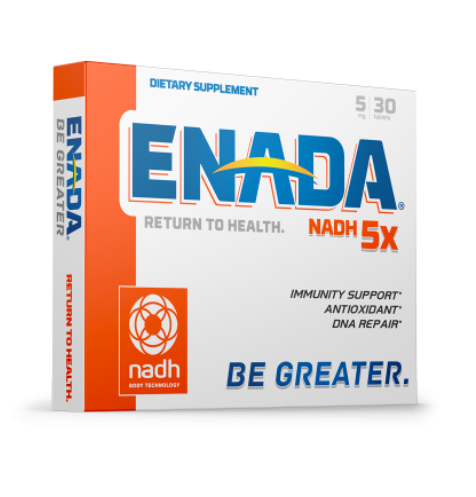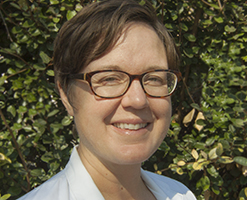
It was Bette Davis who said “getting old ain’t for sissies.”1 I was reminded of this one morning when I turned to pour myself a cup of coffee and threw my back out. That moment was just the straw that broke my back, but I did expect a more heroic act to take me out as I laid on the couch in agony.
Aging – how do we stop it? A decline of a coenzyme called NAD has been suspected as the root of aging.2 NAD (Nicotinamide Adenine Dinucleotide) is involved in energy production, cellular turnover, tissue healing, hormone balance, and general living. NMN (nicotinamide mononucleotide) is the precursor to NAD, which exists in two forms – NADH, the reduced form (having an electron) and NAD+, the oxidized form (not having an electron). Why should this matter? Well, you will rarely see true NAD+ as a supplement because it is pretty unstable.3 NADH and NMN are the two main nutraceutical forms you will find on the market.
Aging – Does your body even know how old you are?

When you read about NAD, by all accounts it’s stated the production “decreases with age.” How does your body know how old you are? I can understand the time accumulation of stress and inflammation, but can we think of ourselves as batteries that eventually lose our charge? Do we just gradually dim our lights? When you turn 40, later that afternoon, does your body just schedule a series of power outages? What drives this decrease of NAD production exactly?
NADH supplies an electron to the process of energy production in our bodies. Our mitochondria are the power plants of our cells. They are organelles that make our ATP (adenosine triphosphate) – the biochemistry fuel for living. What makes the mitochondria unique is that they have special folds allowing for electron gradients. Like your favorite playground equipment, a gradient is a slide. At the top of the slide, you have loads of potential energy and there is really only one direction – down. Gradients in biochemistry set up force and flow, much like a river. River currents do not change direction; they flow, with force, which turns a turbine and generates electricity. So, you can think of the mitochondria as a place where the electrons, through many chemical pumps and gated channels, flow so that energy (ATP) is created.
Oxidative stress steals electrons, and thus decreases the ability for the mitochondria to turn out ATP. What would cause the theft of electrons and decrease that NAD? Junk food, stress, emotional abuse, lack of sleep, alcohol, smoking, oxidative preservatives in food, flavor enhancers, pesticides, food dyes, chemical perfumes, harsh cleaning products and detergents, as well as viral and bacterial infections, just to name a few. You can think of oxidative stress drying up the river of electrons that flow in the mitochondria. Instead of that robust current of electrons, there is now only a trickle.
Your Brain Can Benefit from NAD 🧠
We have some pretty energy-expensive organs – the brain, heart, liver, digestion, kidney system, all require a lot of energy to maintain. Of these, the brain is the priciest. Age-related cognitive decline and poor recall seem to catch us in our advanced years. Research in mouse models actually shows that NAD+ is disrupted in Alzheimer’s disease.4 Furthermore, researchers found treatment with NMN or forms of NADH does restore the levels in the brain and improve learning and memory.5 This is likely because NADH is involved in the process of creating neurotransmitters, the chemical messengers that help us think and remember. NAD’s main creation pathway is from tryptophan, the amino acid precursor to serotonin. Dopamine, epinephrine, norepinephrine, and serotonin are your main neurotransmitters. Not only involved in thinking and memory recall, these neurotransmitters regulate mood.
Your Heart Can Benefit from NAD ❤️
One can make an argument that the second most expensive organ is your heart. As we age, our cardiac vessels stiffen, artery wall damage leads to blockages which leads to heart attacks and congestive heart failure. NAD supplementation has been found to improve blood flow by increasing blood vessel elasticity and creating new blood vessels.6 NAD also has been studied to modify cholesterol and insulin resistance. Published clinical trials showed lower triglyceride, LDL (“the bad”) cholesterol, and improved insulin resistance.7
Fatigue & Injury Support with NAD

It seems that, by these accounts, restoring efficiency with cellular energy production leads to improved tissue turnover, function and, in general, healing. What about muscle weakness and fatigue? And what about injury – bouncing back from when we throw our backs out?
In a study of 242 people with chronic fatigue syndrome, NAD with CoQ10 were found to reduce subjective fatigue as well as improve exercise workload. The subjects had better cardiac output but also reported less muscle stiffness and trigger point pain.8 NAD is stored in muscles. So, when you have a muscle injury (like when you throw your back out) being depleted in NAD delays that healing.9
So, how can you use NADH and NMN?
In general, NADH seems to be used for brain and nerve support. In the dementia studies, forms of NADH were largely given. NMN is absorbed into the bloodstream and converted to NAD+ where it is stored in muscles. This is also the form that seems to improve cardiac health, cholesterol and insulin resistance.

Can you take too much? Niacin is the B-Vitamin (B3) that is used to form NAD. Too much niacin is possible – doses above 500 mg can cause a flushing sensation and taken long-term can create liver toxicity. This dose should be taken under the watch of a trained medical professional.10 That said, NMN and NADH don’t cause flushing, but we think about that with the dosing. NADH dosing is typically around 5-10 mg per day and NMN dosing is around 125-300 mg per day. A reliable product that I have personally used for cognitive support, fatigue, and mental clarity is ENADA. It is a small tablet and I am always amazed at how it lifts my brain fog. As for my back incident – NMN Nicotinamide Mononucleotide by Jarrow – 1 cap per day, and I have not thrown my back out since. But I did give up coffee.
Like chasing a rainbow, we cannot outrun aging. But that doesn’t mean we stop trying to understand it. Knowing how to support your body with healthy physical, nutritional, and emotional choices will be your best investment. We cannot stop time, but we can certainly live better with the time we have.
Note: Product varies by location. Click here to shop online or call your neighborhood location for product availability. Currently, ENADA and NMN by Jarrow are carried at our North Lamar and Lakeline locations.
If you have comments and/or questions about this blog, email us at blog@peoplesrx.com.

Amy Nelson, ND* received her Naturopathic Doctorate from the National College of Natural Medicine in Portland, OR where she studied nutrition, homeopathy, herbal and functional medicine. In addition, Dr. Nelson was the Associate at The IBS Treatment Center in Santa Monica where she treated irritable bowel syndrome and complex food allergies. Dr. Nelson utilizes her experience in natural medicine to address female and male hormonal imbalances, mental health, and digestive disorders. Amy is available for consultation at: DrAmyNelsonND.com.
*Although licensed in other states, Naturopathic Doctors are not currently licensed in Texas. To support licensure efforts, please visit www.txand.org.
References:
- https://www.goodreads.com/quotes/845554-getting-old-ain-t-for-sissies
- https://www.sciencedirect.com/science/article/pii/S0006295222000405
- Ying, Weihai. “NAD+ and NADH in cellular functions and cell death.” Front Biosci 11.1 (2006): 3129-3148.
- van der Velpen V., Rosenberg N., Maillard V., Teav T., Chatton J.Y., Gallart-Ayala H., Ivanisevic J. Sex-specific alterations in NAD+ metabolism in 3xTg Alzheimer’s disease mouse brain assessed by quantitative targeted LC-MS. J. Neurochem. 2021;159:378–388. doi: 10.1111/jnc.15362
- Hosseini L., Mahmoudi J., Pashazadeh F., Salehi-Pourmehr H., Sadigh-Eteghad S. Protective Effects of Nicotinamide Adenine Dinucleotide and Related Precursors in Alzheimer’s Disease: A Systematic Review of Preclinical Studies. J. Mol. Neurosci. MN. 2021;71:1425–1435. doi: 10.1007/s12031-021-01842-6.
- Abdellatif M, Bugger H, Kroemer G, Sedej S. NAD+ and Vascular Dysfunction: From Mechanisms to Therapeutic Opportunities. J Lipid Atheroscler. 2022 May;11(2):111-132. doi: 10.12997/jla.2022.11.2.111. Epub 2022 Apr 6. PMID: 35656147; PMCID: PMC9133775.
- Zhong O, Wang J, Tan Y, Lei X, Tang Z. Effects of NAD+ precursor supplementation on glucose and lipid metabolism in humans: a meta-analysis. Nutr Metab (Lond). 2022 Mar 18;19(1):20. doi: 10.1186/s12986-022-00653-9. PMID: 35303905; PMCID: PMC8932245.
- Castro-Marrero J, Segundo MJ, Lacasa M, Martinez-Martinez A, Sentañes RS, Alegre-Martin J. Effect of Dietary Coenzyme Q10 Plus NADH Supplementation on Fatigue Perception and Health-Related Quality of Life in Individuals with Myalgic Encephalomyelitis/Chronic Fatigue Syndrome: A Prospective, Randomized, Double-Blind, Placebo-Controlled Trial. Nutrients. 2021 Jul 30;13(8):2658. doi: 10.3390/nu13082658. PMID: 34444817; PMCID: PMC8399248.
- Goody MF, Henry CA. A need for NAD+ in muscle development, homeostasis, and aging. Skelet Muscle. 2018 Mar 7;8(1):9. doi: 10.1186/s13395-018-0154-1. PMID: 29514713; PMCID: PMC5840929.
- LiverTox: Clinical and Research Information on Drug-Induced Liver Injury [Internet]. Bethesda (MD): National Institute of Diabetes and Digestive and Kidney Diseases; 2012-. Niacin. [Updated 2020 Jul 9]. Available from: https://www.ncbi.nlm.nih.gov/books/NBK548176/
